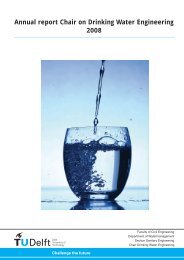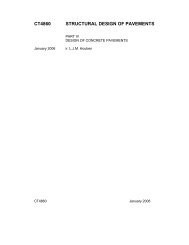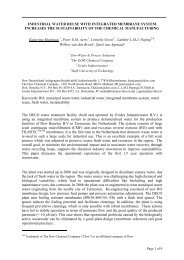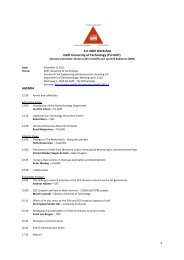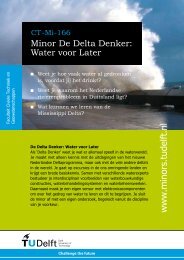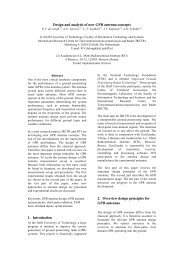Annual report Chair on Drinking Water Engineering 2007 - TU Delft
Annual report Chair on Drinking Water Engineering 2007 - TU Delft
Annual report Chair on Drinking Water Engineering 2007 - TU Delft
Create successful ePaper yourself
Turn your PDF publications into a flip-book with our unique Google optimized e-Paper software.
INTEGRATED MODELING OF OZONATION FOR OPTIMIZATION OF DRINKING<br />
WATER TREATMENT<br />
Research objectives<br />
The research has two objectives: to determine the objectives for optimizati<strong>on</strong> of operati<strong>on</strong> of drinking water treatment<br />
plants and to develop an integrated model for oz<strong>on</strong>ati<strong>on</strong> that can be used for operati<strong>on</strong>al support and process<br />
c<strong>on</strong>trol. The model has to be able to functi<strong>on</strong> as a part of an integrated model for the entire Weesperkarspel<br />
drinking water treatment plant of <strong>Water</strong>net.<br />
Project outline<br />
Introducti<strong>on</strong><br />
In the Netherlands, drinking water treatment plants are robust and designs are based <strong>on</strong> the performance of<br />
individual processes with pre-set boundary c<strong>on</strong>diti<strong>on</strong>s. In operati<strong>on</strong> of drinking water treatment plants, the processes<br />
are usually optimized individually <strong>on</strong> the basis of “rules of thumb” and operator knowledge and experience.<br />
However, changes in operati<strong>on</strong>al c<strong>on</strong>diti<strong>on</strong>s of individual processes can affect subsequent processes and an optimal<br />
operati<strong>on</strong>, which can include a number of water quality parameters, costs and envir<strong>on</strong>mental impact, is different<br />
for every operator. It is assumed that an integrated approach to the entire treatment plant can lead to a more<br />
������������������������������������������������������������������������������������������������������������������<br />
an instrument for operati<strong>on</strong>al support and for process c<strong>on</strong>trol to further improve the operati<strong>on</strong> of a drinking water<br />
treatment plant, making maximal use of the installed infrastructure and postp<strong>on</strong>ing new investments.<br />
Approach<br />
��������������������������������������������������������������������������������������������������������������������<br />
it describes integrated modeling of oz<strong>on</strong>ati<strong>on</strong>. Oz<strong>on</strong>ati<strong>on</strong> plays a key role in integrated modeling of the treatment<br />
plants of <strong>Water</strong>net, water cycle company for Amsterdam and surrounding areas, that were used in case studies.<br />
����������������������������������������������������������������������������������������������������������������-<br />
���������������������������������������������������������������������������������������������������������������������<br />
oz<strong>on</strong>ati<strong>on</strong> model, experiments in different bench-scale and pilot-scale oz<strong>on</strong>e installati<strong>on</strong>s with different natural waters<br />
are performed. In additi<strong>on</strong> different c<strong>on</strong>trol strategies for oz<strong>on</strong>ati<strong>on</strong> are assessed, a new design for oz<strong>on</strong>e installati<strong>on</strong>s<br />
is developed, and the character and removal of natural organic matter (NOM) prior to oz<strong>on</strong>ati<strong>on</strong> is studied.<br />
Results<br />
The objective for integrated optimizati<strong>on</strong> of the operati<strong>on</strong> of drinking water treatment plants should be the improvement<br />
of water quality and not an a priori reducti<strong>on</strong> of envir<strong>on</strong>mental impact or costs. Therefore modeling efforts<br />
focused <strong>on</strong> water quality modeling. The developed oz<strong>on</strong>ati<strong>on</strong> model was used for evaluating the current c<strong>on</strong>trol strategy<br />
of the full-scale oz<strong>on</strong>e installati<strong>on</strong> at Weesperkarspel and for assessing other c<strong>on</strong>trol strategies for operati<strong>on</strong>al<br />
support and process c<strong>on</strong>trol of oz<strong>on</strong>ati<strong>on</strong>. It is a tool that directly shows the c<strong>on</strong>sequences of changes in operati<strong>on</strong><br />
of the oz<strong>on</strong>e installati<strong>on</strong>. It enables water supply companies to make more objective choices for operati<strong>on</strong>al settings<br />
and, thus, is a valuable tool for c<strong>on</strong>trolling the balance between disinfecti<strong>on</strong>, bromate (a possible carcinogenic<br />
according to the World Health Organizati<strong>on</strong>) formati<strong>on</strong> and AOC formati<strong>on</strong>.From the experimental work and modeling<br />
studies, the importance of the hydraulic c<strong>on</strong>diti<strong>on</strong>s for oz<strong>on</strong>ati<strong>on</strong> was dem<strong>on</strong>strated. The dissolved oz<strong>on</strong>e plug<br />
��������������������������������������������������������������������������������������������������������������<br />
in a pre-treated side stream and dosed to the main stream just before a static mixer. Subsequently, c<strong>on</strong>tact time in<br />
��������������������������������������������������������������������������������������������������������������������-<br />
48 <str<strong>on</strong>g>Annual</str<strong>on</strong>g> <str<strong>on</strong>g>report</str<strong>on</strong>g> DWE <strong>2007</strong>



